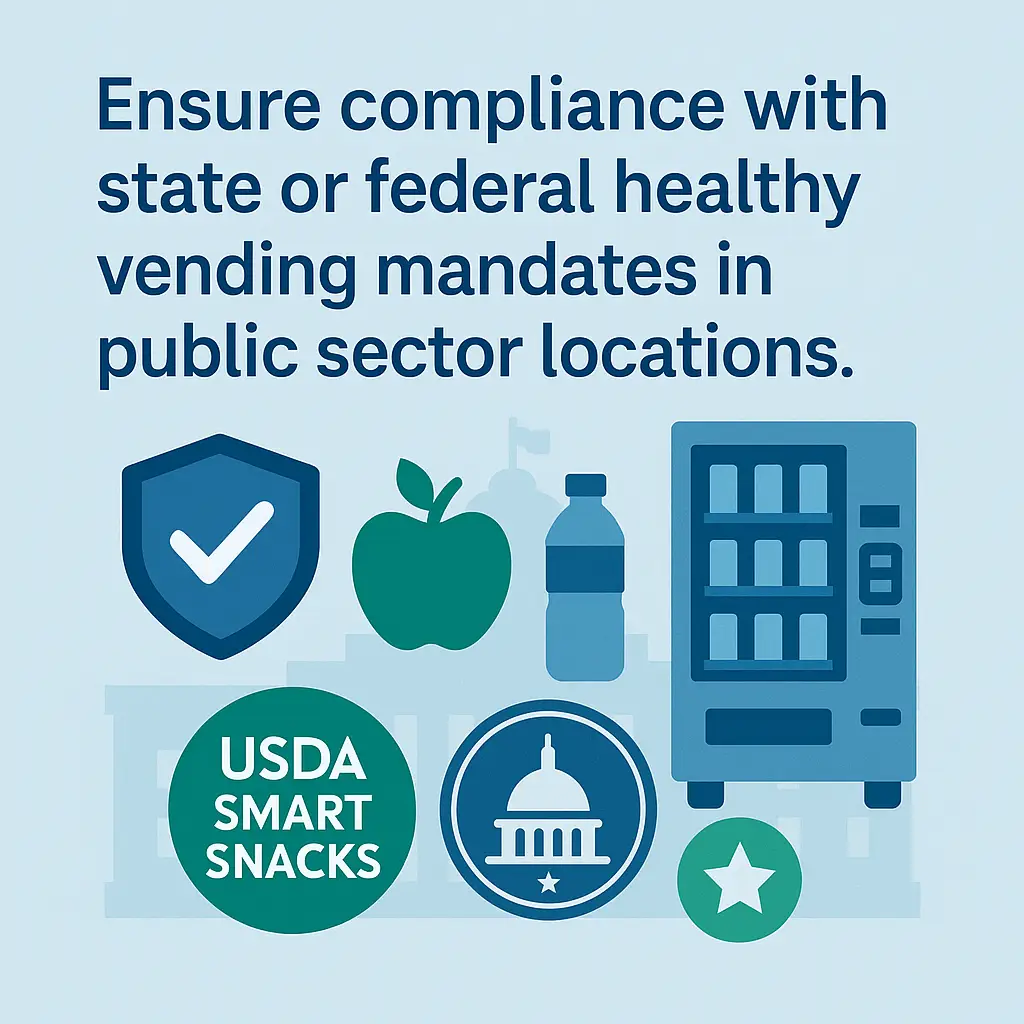Complying with Healthy Vending Policies in Public Facilities
Ensure compliance with state or federal healthy vending mandates in public sector locations.
Back to Vending for Public Buildings ResourcesEnsure compliance with state or federal healthy vending mandates in public sector locations.
Back to Vending for Public Buildings ResourcesHealthy vending policies set nutrition standards for products offered in public facilities, supporting community health while ensuring legal compliance with state or federal guidelines.
![]() Healthy vending supports public wellness initiatives and community health goals
Healthy vending supports public wellness initiatives and community health goals
![]() Compliance reduces legal risks and enhances facility reputation
Compliance reduces legal risks and enhances facility reputation
![]() Clear guidelines simplify product selection and placement decisions
Clear guidelines simplify product selection and placement decisions

Public facilities are increasingly required to comply with healthy vending policies at the state and federal levels. These policies set nutritional standards for food and beverage options offered in places like government buildings, transit stations, schools, and recreation centers. The goal is to improve public health by making nutritious options more accessible in everyday environments. Understanding the scope and requirements of these guidelines is the first step toward effective compliance.
Most healthy vending standards outline clear expectations for product categories, calorie limits, sugar content, portion sizes, and labeling. Administrators must ensure that machines offer qualifying snacks and beverages while maintaining variety and appeal. Common strategies include prioritizing water, low-calorie drinks, baked snacks, and items with reduced sodium or added sugars. Clear signage and transparent labeling also help facilities meet policy requirements and inform consumers.
Each state may have different mandates, and federal guidelines can change over time. Staying informed and maintaining proper documentation is essential for avoiding compliance issues. Public entities should review current standards and integrate them into their vending programs. For practical guidance on machine placement and public accessibility, you can explore related resources on refreshment access in government buildings and vending at transportation hubs.
Selecting the right mix of products is often the most challenging part of compliance. Balancing healthy options with consumer preferences requires thoughtful planning. Facilities should implement regular product audits and monitor sales to ensure ongoing alignment with nutritional standards. It’s also helpful to establish internal policies that mirror external regulations, creating a structured approach to compliance.
Once a compliant vending program is in place, ongoing maintenance is crucial. This includes regularly reviewing updated regulations, refreshing product selections, and evaluating signage. Facilities can benefit from learning how similar institutions handle these challenges. For example, procurement strategies in the public sector offer insight into managing compliance during the vendor selection process.
If you're exploring vending options for your business, Vending Exchange can help simplify the process. Delivery, Installation and Equipment is provided at no cost to you - vendors provide the machines, keep them stocked, and handle all servicing. Whether you need a provider or full-service management, just fill out the form on this page to get started.
These are nutrition standards that regulate which snacks and drinks can be sold in public facilities, ensuring healthier options are available to visitors and staff.
Compliance supports public health goals, meets legal obligations, and enhances the facility’s reputation for community wellness.
Regularly reviewing state and federal health department websites and subscribing to policy updates helps administrators keep current.
Common compliant products include bottled water, low-calorie beverages, baked snacks, items with less added sugar, and reduced-sodium options.
By curating a mix of healthier versions of popular items, facilities can meet guidelines without sacrificing variety or consumer appeal.
No, while federal guidelines set a baseline, each state can add its own requirements, so it’s important to check both.
Most facilities maintain product lists, nutritional information, and policy references to show auditors or inspectors upon request.
Regular reviews, typically every quarter, help ensure that offerings stay aligned with evolving standards and customer preferences.
Yes, some regulations encourage or require machines to be in accessible, high-traffic areas to maximize impact.
Consequences can include warnings, loss of program funding, or reputational damage, depending on the severity and oversight body.